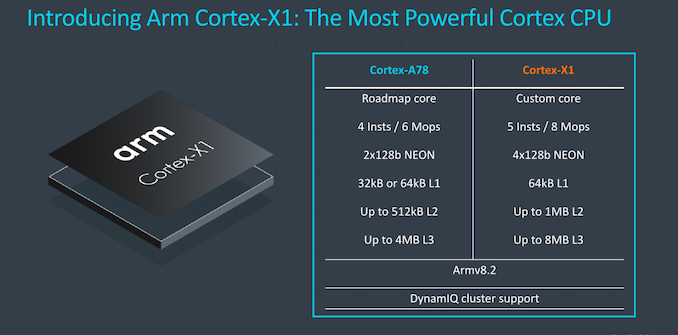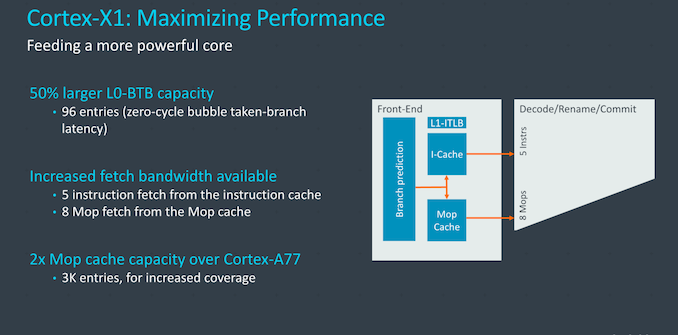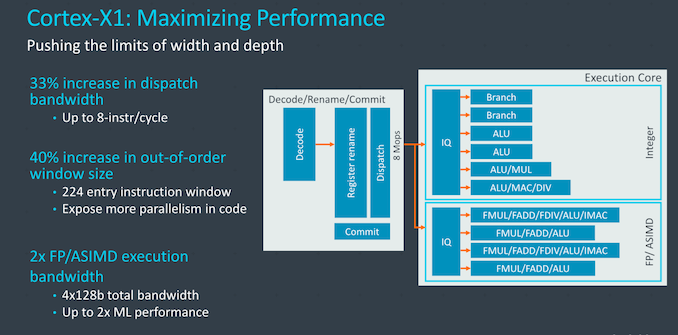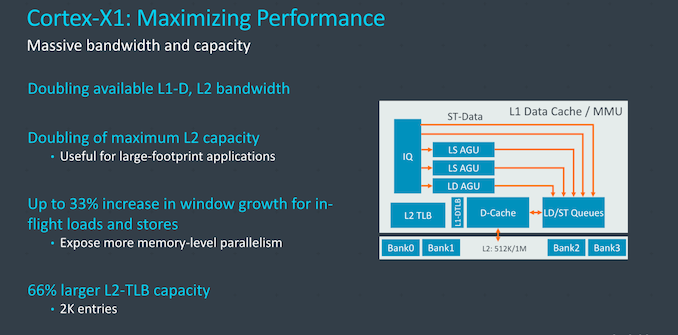Arm's New Cortex-A78 and Cortex-X1 Microarchitectures: An Efficiency and Performance Divergence
by Andrei Frumusanu on May 26, 2020 9:00 AM EST- Posted in
- SoCs
- CPUs
- Arm
- Smartphones
- Mobile
- GPUs
- Cortex
- Cortex A78
- Cortex X1
- Mali G78
The Cortex-X1 Micro-architecture: Bigger, Fatter, More Performance
While the Cortex-A78 seems relatively tame in its performance goals, today’s biggest announcement is the far more aggressive Cortex-X1. As already noted, Cortex-X1 is a significant departure from Arm's usual "balanced" design philosophy, with Arm designing a core that favors absolute performance, even if it comes at the cost of energy efficiency and space efficiency.
At a high level, the design could be summed up as being a ultra-charged A78 – maintaining the same functional principles, but increasing the structures of the core significantly in order to maximize performance.
Compared to an A78, it’s a wider core, going up from a 4- to a 5-wide decoder, increasing the renaming bandwidth to up to 8 Mops/cycle, and also vastly changing up some of the pipelines and caches, doubling up on the NEON unit, and double the L2 and L3 caches.
On the front-end (and valid the rest of the core as well), the Cortex-X1 adopts all the improvements that we’ve already covered on the Cortex-A78, including the new branch units. On top of the changes the A78 introduced, the X1 further grows some aspects of the blocks here. The L0 BTB has been upgraded from 64 entries on the Cortex-A77 and A78, to up to 96 entries on the X1, allowing for more zero latency taken branches. The branch target buffers are still of a two-tier hierarchy with the L0 and L2 BTBs, which Arm in previous disclosures referred to as the nanoBTB and mainBTB. The microBTB/L1 BTB was present in the A76 but had been subsequently discontinued.
The macro-op cache has been outright doubled from 1.5K entries to 3K entries, making this a big structure amongst the publicly disclosed microarchitectures out there, bigger than even Sunny Cove’s 2.25K entries, but shy of Zen2’s 4K entry structure - although we do have to make the disambiguation that Arm talks about macro-ops while Intel and AMD talk about micro-op caches.
The fetch bandwidth out of the L1I has been bumped up 25% from 4 to 5 instructions with a corresponding increase in the decoder bandwidth, and the fetch and rename bandwidth out of the Mop-cache has seen a 33% increase from 6 to 8 instructions per cycle. In effect, the core can act as a 8-wide machine as long as it’s hitting the Mop cache.
On the mid-core, Arm here again talks about increasing the dispatch bandwidth in terms of Mops or instructions per cycle, increasing it by 33% from 6 to 8 when comparing the X1 to the A78. In µops terms the core can handle up to 16 dispatches per cycle when cracking Mops fully into smaller µops, in that regard, representing a 60% increase compared to the 10µops/cycle the A77 was able to achieve.
The out-of-order window size has been increased from 160 to 224 entries, increasing the ability for the core to extract ILP. This had always been an aspect Arm had been hesitant to upgrade as they had mentioned that performance doesn’t scale nearly as linearly with the increased structure size, and it comes at a cost of power and area. The X1 here is able to make those compromises given that it doesn’t have to target an as wide range of vendor implementations.
On the execution side, we don’t see any changes on the part of the integer pipelines compared to the A78, however the floating point and NEON pipelines more significantly diverge from past microarchitectures, thanks to the doubling of the pipelines. Doubling here can actually be taken in the literal sense, as the two existing pipelines of the A77 and A78 are essentially copy-pasted again, and the two pairs of units are identical in their capabilities. That’s a quite huge improvement and increase in execution resources.
In effect, the Cortex-X1 is now a 4x128b SIMD machine, pretty much equal in vector execution width as some desktop cores such as Intel’s Sunny Cove or AMD’s Zen2. Though unlike those designs, Arm's current ISA doesn't allow for individual vectors to be larger than 128b, which is something to be addressed in a next generation core.
On the memory subsystem side, the Cortex-X1 also sees some significant changes – although the AGU setup is the same as that found on the Cortex-A78.
On the part of the L1D and L2 caches, Arm has created new designs that differ in their access bandwidth. The interfaces to the caches here aren’t wider, but rather what’s changed is the caches designs themselves, now implementing double the memory banks. What this solves is possible bank conflicts when doing multiple concurrent accesses to the caches, it’s something that we may have observed with odd “zig-zag” patterns in our memory tests of the Cortex-A76 cores a few years back, and still present in some variations of that µarch.
The L1I and L1D caches on the X1 are meant to be configured at 64KB. On the L2, because it’s a brand new design, Arm also took the opportunity to increase the maximum size of the cache which now doubles up to 1MB. Again, this actually isn’t the same 1MB L2 cache design that we first saw on the Neoverse-N1, but a new implementation. The access latency is 1 cycle better than the 11-cyle variant of the N1, achieving 10 cycles on the X1, regardless of the size of the cache.
The memory subsystem also increases the capability to support more loads and stores, increasing the window here by 33%, adding even more onto the MLP ability of the core. We have to note that this increase not merely refers to the store and load buffers but the whole system’s capabilities with tracking and servicing requests.
Finally, the L2 TLB has also seen a doubling in size compared to the A78 (66% increase vs A77) with 2K entries coverage, serving up to 8MB of memory at 4K pages, which makes for a good fit for the envisioned 8MB L3 cache for target X1 implementations.
The doubling of the L3 cache in the DSU doesn’t necessarily mean that it’s going to be a slower implementation, as the latency can be the same, but depending on partner implementations it can mean a few extra cycles of latency. Likely what this is referring to is likely the option for banking the L3 with separated power management. To date, I haven’t heard of any vendors using this feature of the DSU as most implementers such as Qualcomm have always had the 4MB L3 fully powered on all the time. It is possible that with a 8MB DSU that some vendors might look into power managing this better, for example it having being only partially powered on as long as only little cores are active.
Overall, what’s clear here about the Cortex-X1 microarchitecture is that it’s largely consisting of the same fundamental building blocks as that of the Cortex-A78, but only having bigger and more of the structures. It’s particularly with the front-end and the mid-core where the X1 really supersizes things compared to the A78, being a much wider microarchitecture at heart. The arguments about the low return on investment on some structures here just don’t apply on the X1, and Arm went for the biggest configurations that were feasible and reasonable, even if that grows the size of the core and increases power consumption.
I think the real only design constraints the company set themselves here is in terms of the frequency capabilities of the X1. It’s still a very short pipeline design with a 10-cycle branch mispredict penalty and a 13-stage deep frequency design, and this remains the same between the A78 and X1, with the latter’s bigger structures and wider design not handicapping the peak frequencies of the core.














192 Comments
View All Comments
Wilco1 - Tuesday, May 26, 2020 - link
Disappointed in what way? Flagship phones have been more than fast enough in the last few years. There is a balance between power consumption and performance - and I think the improved efficiency of Cortex-A78 will be more useful in typical use-cases. It won't win benchmarks, but if you believe iPhone performance is measurably better in real-life use (rather than benchmarks), why not just buy one?syxbit - Tuesday, May 26, 2020 - link
Put it in context. You pay $1500 for a Galaxy S20 ultra that's slower than a $400 iphone.If you do a lot of web browsing on javascript heavy pages, nothing beats single threaded perf. You can't improve it by just throwing slower cores at it.
Discourse did a good writeup that's still valid today.
https://meta.discourse.org/t/the-state-of-javascri...
Wilco1 - Tuesday, May 26, 2020 - link
You could also get the $699 OnePlus 8 and beat the S20 ultra on both performance and cost. Where is the difference?Javascript and browsers depend heavily on software optimization, and that's the real issue.
armchair_architect - Tuesday, May 26, 2020 - link
syxbit is right. Javascript and browsers are not just software. They stress CPU in different ways than the usual Spec/Geekbench and X1 will not be just a benchmark core.If you look at DVFS curve of A77 vs A78, X1 will probably be even lower power than A78 in the region of perf in which they overlap.
For the simple reason that to achieve same performance as A77/A78, X1 will need much lower frequency and voltage. This will greatly offset the intrinsic growth in iso-frequency power that X1 will for sure have.
My point would be: going wider helps you be more efficient iso-perf vs narrower cores.
The power efficiency hit only comes when you go over the peak perf offered by the narrower core.
So you could argue that something like X1 is taking the A78 DVFS curve and pushing it down (lower power) and of top of that it extends it to new performance point not even reachable on A78.
Obviously you pay in area for this :)
But Apple has clearly showed over the years that this is the winning formula
ZolaIII - Wednesday, May 27, 2020 - link
You are completely wrong. It's much more about caching than wider core's. X1 is not 50% faster than A78 but it is 50% bigger. Best approach would be wider ISA with same execution units multiplied in numbers like RISC V did lay out already foundations for 256 bit ISA (still a scratch) and is finalising 128 bit one. But there's a catch in tool's and compilers support.soresu - Wednesday, May 27, 2020 - link
X1 does have wider NEON SIMD, twice as wide in fact - so for content that favors SIMD (like dav1d AV1 decoding) you will get a serious jump in performance.Unfortunately the benchmarks do not really give us much of an idea of real world improvement for something like this, so we'll have to wait for products to get a better idea.
dotjaz - Thursday, May 28, 2020 - link
ARM specifically said A78 was designed to INCREASE EFFICIENCY vs A77, a lot of the decisions concur with that.X1 was designed to MAXIMIZE PERFORMANCE sacrificing efficiency and area in the process. When you factor in the leakage caused by larger die. X1 would almost certainly be less efficient than A78 when you drop it to below 2GHz.
Wilco1 - Thursday, May 28, 2020 - link
"Javascript and browsers are not just software."They are just software. Fun fact: your Android browser is built with -Oz. Yes, all optimizations are turned off in order to reduce binary size. That's an insanely stupid software decision which means Android phones appear to be behind iOS when in fact they are not.
name99 - Saturday, May 30, 2020 - link
It's not an "insanely stupid software decision"...Fun fact: Apple ALSO builds pretty much all their software at either -Oz or -Os! Both Apple and Google (and probably MS) are well aware that the "overall system experience" matters more than picking up a few percentage points in particular benchmarks, and that large app footprints hurt that overall system experience. Apple's recommendation for MOST developer code (and followed internally) has been to optimize for size for yikes, at least 20 years, and hasn't changed in all that time.
Look at the (ongoing) work in LLVM to reduce code size ( "outliner" is one of the relevant keywords); the people involved in that span a range of companies. I've seen a lot of work by Apple people, a lot by Google people, some even by Facebook people.
Wilco1 - Saturday, May 30, 2020 - link
There is a world of difference between optimizing performance without regard for codesize and optimizing for smallest possible codesize without any regard for performance. -Ofast is the former, -Oz is the latter. Most software, including Linux distros, uses -O2 as the best tradeoff between these extremes. Non essential applications use -Os (or even -Oz if performance is irrelevant). However a browser is extremely performance sensitive. Saving a few bytes with -Oz loses 10-20% performance and that means you lose the equivalent of a full CPU generation. I call that insanely stupid, there are no other words to describe it.